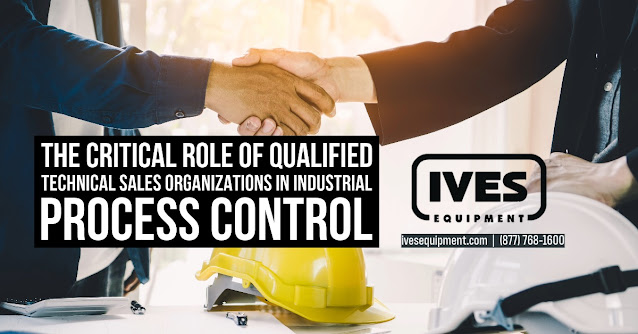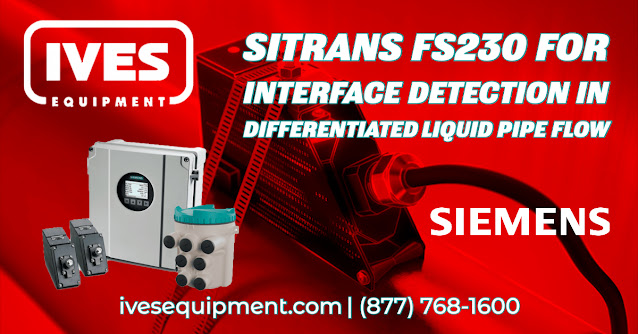Educational information on process control, industrial instrumentation, valves, valve automation and control valves. For additional information visit IvesEquipment.com or call 877-768-1600
Preventing Winter Shutdowns: How Freeze Protection Ensures Continuous Industrial Operations
As winter's icy grip tightens, industries brace for the chilling effects of plummeting temperatures. One of the most significant challenges they face is the risk of operational shutdowns due to freezing conditions. In this scenario, freeze protection becomes a cornerstone for ensuring continuous industrial operations. Freeze protection is critical in preventing winter shutdowns and maintaining industrial productivity.
The first layer of defense against the cold is understanding the risk. Many industrial processes involve fluids – water, chemicals, oils – that can freeze at low temperatures. When these fluids freeze, they can expand, causing pipes and containers to burst or crack, leading to equipment failures, safety hazards, and costly repairs. The consequences aren't just physical; they can significantly impact production schedules, leading to financial losses and compromised client relationships.
This is where heat tracing systems come into play. Heat tracing, an essential component of freeze protection, involves applying heating elements alongside pipes, valves, tanks, and other critical components. These systems maintain a constant temperature, preventing the contents from freezing. Modern heat tracing solutions are sophisticated, with self-regulating capabilities that adjust the heat output based on the surrounding temperature. This ensures energy efficiency while providing reliable freeze protection.
Beyond heating elements, insulation is another vital aspect of freeze protection. Insulating pipes and tanks reduce heat loss, allowing heating systems to work more effectively and efficiently. The suitable insulation materials, combined with expert installation, can significantly reduce the risk of freezing.
Automation and monitoring technologies have also revolutionized freeze protection. With real-time monitoring systems, industries can remotely track the temperatures of their equipment and receive instant alerts if temperatures approach dangerous levels. This proactive approach allows for quick responses, minimizing the risk of a freeze-induced shutdown.
The implementation of freeze protection strategies must be a tailored process. Each industry and facility has unique needs based on its location, the nature of the materials handled, and the specific equipment used. A comprehensive risk assessment is crucial to identify vulnerable areas and design a freeze protection system that addresses these risks effectively.
Training and preparedness are equally important. Employees should be trained in the proper operation of freeze protection systems and emergency response procedures should a system failure occur. This training ensures that issues are addressed swiftly and effectively, minimizing downtime.
Industries must also consider the environmental impact of their freeze protection strategies. Eco-friendly antifreeze solutions, energy-efficient heat tracing systems, and sustainable insulation materials are increasingly available, allowing industries to protect their operations from the cold while being mindful of their environmental footprint.
In conclusion, as the cold season approaches, the importance of freeze protection in industrial settings cannot be overstated. It is a multifaceted approach involving heat tracing, insulation, monitoring, tailored solutions, training, and environmental consideration. By adopting these strategies, industries can safeguard against winter shutdowns, ensuring their operations run smoothly and continuously, regardless of the outside temperature. This proactive approach protects equipment and investments and secures the industry's reputation as a reliable and resilient player in the market.
Ives Equipment Corp., a leader in industrial solutions, is proud to offer an extensive range of Nelson Heat Trace products, renowned for their reliability and efficiency in freeze protection and process temperature maintenance. Our dedicated team specializes in these cutting-edge systems' sales, design, and comprehensive support, ensuring your industrial operations remain uninterrupted, even in the harshest winter conditions. With our in-depth expertise, we provide tailored solutions that align perfectly with your unique requirements. Partnering with Ives Equipment Corp. means gaining access to top-tier heat tracing technology backed by a commitment to exceptional customer service and technical support. Trust us to keep your operations running smoothly, regardless of the weather.
https://ivesequipment.com
Mastering Industrial Efficiency: Ives Equipment in Process Weighing
Process weighing is essential in manufacturing and industrial applications. It ensures that products meet specific quality and safety standards. Even slight weight variations can significantly influence the product's quality, safety, and effectiveness in industries where accuracy is critical.
There are two primary methods of process weighing: continuous and static.
Continuous weighing monitors materials as they continuously flow through a system. This method is prevalent in industries that handle bulk materials, such as the food, beverage, or chemical sectors, where raw materials consistently move through production lines. Continuous weighing ensures consistency in the quantity and quality of materials throughout production.
In contrast, static weighing focuses on weighing stationary items and is used when products need validation against a particular weight or standard. For instance, in packaging, static weighing ensures that packages have the correct product quantity before being sent to customers.
Batching technology ensures that products or raw materials are grouped into specific, predetermined amounts in tandem with these weighing techniques. Batching provides the right mix of components in sectors where various ingredients form a product, resulting in uniform product quality. This process is especially vital in the food and pharmaceutical sectors, where precision and consistency are crucial for health and safety.
In summary, process weighing is a determining factor in the industrial realm, assuring product quality, safety, and efficiency. Leveraging the technological strengths of Ives industrial weighing systems, industries can achieve the meticulousness and dependability necessary to thrive in the competitive marketplace.
https://ivesequipment.com
Clamp-on Flow: The Benchmark in Installation Ease
Clamp-on ultrasonic flowmeters are among the most cost-effective and accurate technologies for measuring volumetric flow and are preferred in flow measurement for several reasons:
- Non-Intrusive Measurement: Unlike other flowmeters, clamp-on ultrasonic devices are installed on the exterior of the pipe. This means there's no need to cut into the pipe or halt the process for installation, leading to minimal disruption.
- Low Maintenance: Since they are externally mounted and don’t have any moving parts, these flowmeters typically require less maintenance compared to their intrusive counterparts.
- Flexibility: These flowmeters can be used for various pipe sizes and materials. Their design allows for adjustments, making them suitable for a wide range of applications.
- Cost-Effective: Installation is generally quicker and easier than intrusive meters, reducing labor costs. Plus, there's no need to purchase additional fittings or shut down the system for installation.
- Safe Measurement: Because they don't come into direct contact with the liquid or gas being measured, there's a reduced risk of contamination or leakage. This is particularly beneficial when dealing with hazardous or corrosive substances.
- Wide Range of Applications: They can measure the flow of liquids, gases, and steam, making them versatile for different industries and applications.
- No Pressure Drop: Since they are non-intrusive, there's no added resistance or obstruction in the flow, ensuring that the system operates at its optimal efficiency.
- Ability to Measure Dirty Liquids: Some ultrasonic flowmeters can measure flows even when the liquid has some impurities or particles, which might be challenging for other meter types.
Even though clamp-on flowmeters come with a low cost of ownership and advanced features, they aren't as popular as other established flow measurement systems. Some customers view clamp-on meters as challenging to install and operate.
610-768-1600
https://ivesequipment.com
The Critical Role of Qualified Technical Sales Organizations in Industrial Process Control
As industries evolve and new technological advancements emerge, the role of a highly qualified technical sales organization has become increasingly vital in various industrial sectors. Particularly in industries such as water treatment, petrochemical, chemical, pharmaceutical, food and beverage, and power generation, a specialized technical sales team that sells industrial process control instrumentation and industrial valves is crucial in achieving business growth and success.
- Identifying Customer Needs: A skilled technical sales team possesses the knowledge and expertise to understand complex industrial systems. They can work closely with customers, identifying their specific requirements and challenges, thereby offering tailored solutions that best address their needs. This consultative approach builds customer trust and strengthens long-term relationships.
- Supporting Business Growth: Technical sales teams drive sales and revenue growth by providing appropriate and optimal solutions to customers. They actively seek out new opportunities and target prospective customers with offerings that match their unique needs. Their in-depth understanding of the technology enables them to align the company’s products and services with diverse industrial sectors' current and future requirements.
- Uncovering New Markets and Applications: A highly qualified technical sales team excels in discovering new markets and application areas where their products and services can create value. By leveraging their industry expertise, these sales professionals identify new opportunities and help expand the reach of their products into untapped markets. In doing so, they contribute significantly to the company’s growth strategy.
- Delivering Product Expertise: Industrial process control instrumentation and industrial valves can be complex products requiring high technical knowledge. Sales teams specializing in these products deeply understand their specifications, applications, and benefits. They can explain the intricacies of these products, helping customers make informed purchasing decisions.
- Providing Post-Sales Support: A qualified technical sales team doesn’t just close deals; they provide valuable post-sales support. Whether it’s assisting with installation, troubleshooting technical issues, or training the customer’s staff, these professionals ensure the smooth integration of their products into the customer’s operations. This service fosters customer loyalty and encourages repeat business.
- Mitigating Market Risks: In volatile industries such as petrochemical and power generation, changes in regulations, technology, and market demand can create uncertainties. A proficient technical sales team keeps abreast of industry trends and regulatory changes. They help their organization adapt to these shifts by offering products and solutions that align with the changing market landscape.
- Accelerating Innovation: Technical sales teams act as a bridge between the company and its customers. They collect feedback from customers regarding product performance, needs, and challenges. This feedback helps the company’s R&D team develop innovative products and solutions that meet emerging industry needs.
- Enhancing Customer Satisfaction: By providing tailored solutions, excellent customer service, and reliable support, a qualified technical sales team enhances customer satisfaction. Satisfied customers become brand advocates, leading to increased referrals and new business opportunities.
A highly qualified technical sales organization is indispensable in the industrial process control sector. Their in-depth knowledge, industry expertise, and customer-centric approach drive sales growth discover new markets and applications, and build strong customer relationships. As technology continues to evolve and industrial requirements change, the importance of these technical sales teams will only continue to grow.
Ives Equipment
610-768-1600
Interface Detection in Differentiated Liquid Pipe Flow with Clamp-on Ultrasonic Meter
Interface detection in differentiated liquid pipe flow refers to identifying and monitoring the boundary between two immiscible fluids (liquids that do not mix) flowing through a pipe in process control applications. In industries such as oil and gas, petrochemicals, and wastewater treatment, it is common to have a line transporting two or more immiscible liquids, often referred to as a multiphase flow. Efficient and accurate interface detection is crucial for optimizing separation processes, minimizing product contamination, and preventing damage to equipment.
Ultrasonic sensors transmit high-frequency sound waves through the fluid and measure the time it takes for the waves to reflect the interface. By analyzing the received signals, the sensors can determine the position of the interface within the pipe.
In process control, interface detection is often combined with other control strategies, such as flow rate control or temperature control, to ensure the efficient and safe operation of the process. Accurate interface detection allows for better process optimization, reduces the risk of equipment damage due to improper fluid handling, and improves overall product quality.
The Siemens SITRANS FS230 clamp-on ultrasonic interface detector is an exceptional option for applications that necessitate the detection of differentiated liquid pipe flow. It achieves this by computing the sonic velocity and pressure while adjusting for temperature variations. This direct measurement approach for interface detection leads to significant savings in equipment utilization and slop oil treatment.
The FS230 interface detector can provide oil companies with highly accurate and dependable flow and interface information for a broad range of applications, such as:
- Detecting gasoline interfaces
- Identifying multi-product interfaces
- Determining product types
- Managing automatic batching control
- Detecting entrained water and gas presence in all products
Electronic Pressure and Temperature Switches
Industrial electronic pressure and temperature switches measure and control pressure and temperature in industrial processes. These devices typically consist of an electronic sensor, which measures the pressure or temperature, and an electronic control circuit, which compares the process value to a set point and generates an output signal.
The electronic sensor can be a piezoelectric, strain gauge, RTD, or thermocouple device. The electronic control circuit typically includes a microcontroller or microprocessor that can be programmed to perform various functions, such as controlling pressure or temperature, monitoring process variables, and communicating with other electronic devices.
Industrial electronic pressure and temperature switches are used in a wide range of industrial applications, including HVAC, oil and gas, chemical processing, food and beverage, and power generation. They are commonly used to control pumps, compressors, valves, and other process equipment to ensure optimal performance and safety.
Industrial electronic pressure and temperature switches have several advantages over electromechanical switches:
- Greater accuracy: Electronic switches use electronic sensing elements, which are more accurate than mechanical ones.
- Faster response time: Electronic switches can respond much faster to changes in pressure or temperature than mechanical switches.
- Greater durability: Electronic switches have no moving parts, so they are less likely to wear out or fail.
- Increased flexibility: Electronic switches can be programmed to perform a variety of functions and are easily integrated with other electronic devices.
- Lower maintenance: Electronic switches require less maintenance than mechanical switches, as they have no moving parts to wear out.
- Greater control: Electronic switches can be programmed for various set points and output multiple signals.
- Cost Savings: Electronic switches are generally less expensive over their lifetime because of their durability and lower maintenance requirements.
Sanitary and Hygienic Tubing, Fittings, Valves, and Pumps
Sanitary and hygienic tubes, fittings, valves, and pumps are used in a variety of industries, such as food and beverage, pharmaceuticals, and biotechnology, to convey materials and fluids in a safe and clean manner. These types of equipment are designed to meet strict standards for cleanliness and sanitation, which helps to prevent contamination and maintain the purity of the products being transported.
One of the key advantages of using sanitary and hygienic equipment is that it is designed to minimize the potential for bacterial growth. This is achieved through the use of materials that are resistant to corrosion and easy to clean, such as stainless steel and other high-grade alloys. The surfaces of these components are typically smooth and polished, which reduces the ability of bacteria to adhere to them and makes it easier to remove any contaminants that may be present.
Another important factor that contributes to the safety and purity of products conveyed through sanitary and hygienic equipment is the use of high-quality seals and gaskets. These components are designed to prevent the leakage of fluids and minimize the potential for cross-contamination between different products. They also help to maintain the integrity of the system by preventing the ingress of dust, dirt, and other contaminants.
Valves used in the sanitary and hygienic applications are designed to be easily disassembled and cleaned, some of them even can be cleaned in place (CIP). This makes it much easier to maintain the system and keep it in a sanitary condition. Pumps also have a similar design feature like the valves. The design of the pumps is critical in maintaining the purity of the products being transported. They are typically constructed with high-grade materials and feature smooth, polished surfaces that are easy to clean.
In summary, the use of sanitary and hygienic equipment provides a number of advantages when it comes to maintaining the purity and safety of products. The equipment is designed to minimize the potential for contamination, through the use of materials that are resistant to corrosion and easy to clean, high-quality seals and gaskets, and design that enable easy cleaning. All of these factors contribute to a safer and more efficient system that can help to ensure the quality and purity of the products being conveyed.
Subscribe to:
Comments (Atom)





